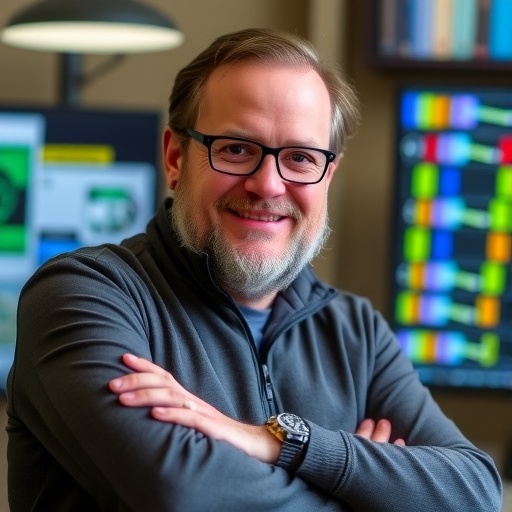In a remarkable intersection of materials science and engineering, a significant breakthrough has emerged from Lehigh University, where Professor Martin Harmer has devised an innovative copper-based superalloy. This significant advancement is not only a testament to the collaborative efforts of his team but also has garnered global recognition, as it has been included in the Falling Walls Foundation’s elite Top 10 Breakthroughs of the Year 2025 in Physical Sciences. Harmer, an esteemed Alcoa Foundation Professor Emeritus of Materials Science and Engineering, has been pivotal in redefining the landscape of superalloy research, signalling a potential paradigm shift in high-temperature materials.
Superalloys, traditionally composed of nickel, cobalt, or iron, have been the bedrock of modern engineering, providing the necessary strength and stability to withstand the rigors of extreme environments such as those found in aerospace and power generation. However, these alloys have long been limited in their temperature capabilities, relying predominantly on single crystal Ni-based alloys to achieve structural integrity under intense heat. Harmer’s pioneering work has successfully breached a century-old limitation by producing a new class of superalloy that utilizes copper as its base metal, promising unprecedented performance characteristics.
The specific breakthrough, aptly titled “Breaking the Wall of 100 Years of Superalloys,” emerges from a deep understanding of nanocrystalline materials and the crucial role played by grain boundaries and atomic interfaces within these materials. Harmer’s research contends with a common misconception in materials science: that these grain boundaries are mere flaws. Instead, through a series of meticulous experiments and advanced engineering techniques, Harmer’s team has demonstrated that these interfaces can be manipulated to enhance the mechanical properties of the alloy significantly.
Inspired by Richard Feynman’s revolutionary thoughts on atomic-level engineering, Harmer’s research took a significant turn when his team began to explore the concept of complexions—phase-like structures located at atomic interfaces. By leveraging precision electron microscopy and methodical experimentation, researchers discovered a way to stabilize nanostructures within the material, preventing the degradation that commonly plagues nanocrystalline materials at elevated temperatures. This transformative approach posits that engineering the grain boundaries can convert a material’s weaknesses into strengths, reshaping how scientists view and apply these materials.
One of the salient characteristics of Harmer’s new copper-based superalloy is its ability to maintain structural integrity at high temperatures without succumbing to the creep deformation that typically afflicts traditional superalloys. Characterized by an innovative Cu–Ta–Li composition, this new superalloy capitalizes on the unique properties of tantalum-rich complexions which stabilize nanoscale Cu₃Li precipitates. By utilizing advanced cryogenic high-energy milling techniques, the team was able to create a metastable solid solution that exhibits extraordinary resilience under prolonged stress at elevated temperatures.
The implications of this discovery are profound, extending well beyond the confines of materials science into practical applications that touch everyday life. The enhanced thermal and electrical conductivity of this copper-based superalloy presents tantalizing possibilities for innovations across various industries, ranging from advanced telecommunications systems to energy-efficient propulsion in aerospace applications. Harmer envisions a future wherein this research paves the way for entirely new classes of thermally stable alloys that could redefine performance standards in high-stakes environments.
As one examines the depths of this research, it becomes clear that Harmer’s work embodies a significant leap forward in a field that has remained largely stagnant for decades. The ability to manipulate complexions and maintain nanoscale structures could revolutionize the colossal energy sector, contributing to more efficient turbine designs and promoting advances in sustainable transport solutions. Harmer’s findings catalyze a transformative dialogue about the integration of materials science with technological innovation, where materials can be purposefully developed to overcome existing limitations.
Furthermore, as a reflection of the momentum in his field, Harmer’s accolade from the Falling Walls Foundation not only primes his work for increased visibility but also sets the stage for future collaborations and advancements. The recognition from international peers underscores the global significance of his contributions and emboldens a community of scientists and engineers to strive for a greater understanding and implementation of advanced materials.
Amid the excitement of this achievement, Harmer remains grounded and emphasizes the ethos behind his work—a testament to the collaborative spirit of science. His words resonate with the vision of pushing boundaries and changing conventions, reminding us of the fundamental reasons scientists pursue discovery. Through teamwork and shared aspirations, the ambition to catalyze change within scientific disciplines is indeed a vivid reality.
Moreover, the scientific community stands at a pivotal junction where traditional views of materials must adapt to new discoveries that challenge established norms. Harmer’s breakthrough not only offers practical solutions to immediate engineering challenges but also compels a reconsideration of how future materials can be designed and utilized. The narrative woven through this research exemplifies that the true spirit of innovation lies in questioning the status quo and nurturing an atmosphere of inquiry that remains unbounded by convention.
As the echoes of Harmer’s groundbreaking work resonate through the halls of academia and industry alike, the dialogue surrounding superalloys is bound to evolve. The scientific significance of this research promises to shift paradigms, reflecting a deeper understanding of material properties and the potential they hold for reshaping technology. In doing so, it amplifies the message that the journey of scientific inquiry is both rigorous and dynamic, continually redefining the possible.
Ultimately, incorporating copper into high-performance superalloys introduces a fascinating chapter into the storied history of materials science, laying the groundwork for innovations that could define the next century of engineering. Harmer’s research not only symbolizes a significant advancement in material design but also encapsulates the drive towards enhancing human capability through scientific endeavor. This marriage of discovery and application paves the way for future innovations that might very well change the landscape of technology, energy, and beyond.
Subject of Research: Copper-based superalloys
Article Title: Lehigh University Breaks Ground with New Copper-Based Superalloys
News Publication Date: [Insert Publication Date]
Web References: [Insert Web References]
References: [Insert References]
Image Credits: Lehigh University




